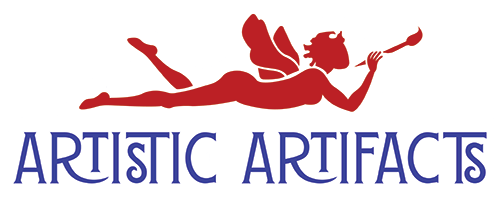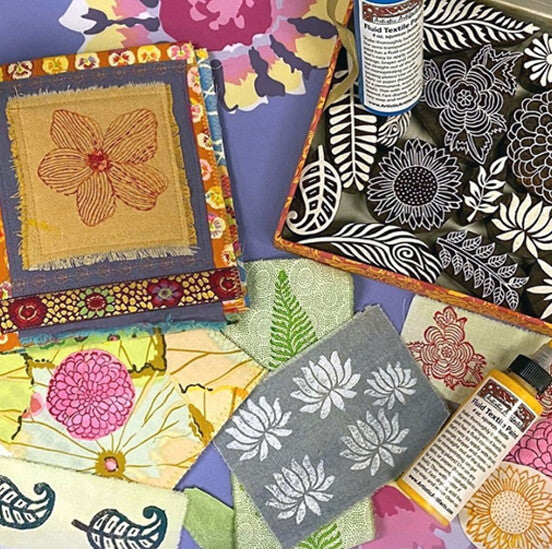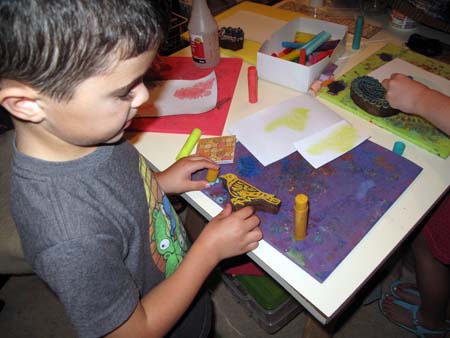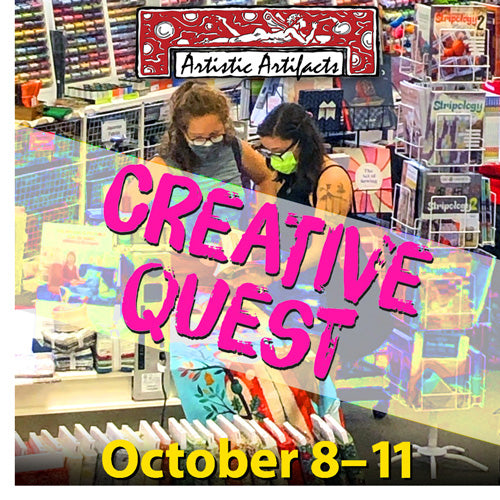Exploring the Possibilities of Gelatos: Part 2

Tag preprepped with found papers, clear and white gesso, and modeling paste texture, colored with Gelatos by Marjie Curia.
— View Part 1 of Exploring Gelatos
On Thursday, August 14, 2014 we are having Jen Bell, one of the members of Judy’s Altered Minds (JAMs) come in to lead us in a demonstration of how to use ICE resin and Susan Lenart Kazmer’s ICED Enamels, cold enameling powders and inclusions on paper/illustration board to create Artist Trading Cards (ATCs). Jen brings her creative efforts every month for exchange and everyone goes nuts for them, so she has generously agreed to share her processes. Join us!
So, now that we are a month away from the previous session, it is long past time for Part 2 of our posting describing the versatility of Gelatos® from Faber-Castell, isn’t it? (Part 1 is available here) I was busy packing merchandise up for the CREATE art retreat in New Jersey, so Sharon McDonagh took over leading the group. We’ll begin with her continuation, and conclude with my “assignment,” which I undertook with my personal creative team!
Exploring Gelatos Part 2, section A, by Sharon McDonagh
Gelatos love texture, so they work beautifully on velvet. We took some pale pink velvet ribbon and completely transformed it.
Above, stroke different colors of Gelatos directly on ribbon and blend with your finger. Mist with water if desired for blending. As noted in Part 1 of our article, you can also apply just a few strokes of Gelatos onto your non-stick ironing and craft sheet (or freezer paper) and mist that with water to create a puddle of beautiful dye-like color that can be applied with a brush, by sponging it on, or by dipping the fabric in, etc. Vary the intensity of your color by altering the amount of water added.
Above, quite a transformation from the original pale pink (top), wouldn’t you agree? (The heart is a punched piece of watercolor paper: this had several colors of Gelatos stroked on without any blending, then it was misted with water. The bit of color meld and texture you see was created simply by the water application.)
Gelatos with Wooden Printing Blocks

Tag colored with Gelatos and stamped using wooden printing blocks.
Okay, so onto our discovery, as promised in Part 1. As noted then, Gelatos are ideal for use on foam stamps, because of the foam’s texture...and thinking of surface texture got me wondering about using wooden printing blocks.
Rather than risk it with Judy’s extensive stash, I first tried this with my own block, a mermaid. It worked! After success with a solid color print, I realized that with the Gelatos’s stick form and thick consistency, I could color areas of the block selectively. Painting selectively is hard to do when using textile or acrylic paint on your block, as by the time you get to one area, the paint is drying up elsewhere. With Gelatos being “activated” with the addition of water, you have a longer working time.
Below, a mermaid print on paper. The background was lightly colored with Gelatos and stamped with a foam circle for bubbles. The bottom ‘ocean floor’ is homemade washi tape, artist tape colored with Gelatos. Below the mermaid you can see the wooden printing block used to create her.
Below, Beth Richardson’s mermaid print, on created on Roc-lon® Roc-rol™ Multi-Purpose Cloth™.
Above, selectively applying different colors of Gelatos to a graphic circle wooden printing block.
I’ve applied Gelatos to a number of types of fabrics/weights, with beautiful results. But my experiments with fabric had previously all been done with the intention of using the material in either a mixed media piece or an art quilt that wouldn’t be laundered.
To answer a customer who emailed us asking whether Gelatos could be used to draw on fabric for a quilt, I took a piece of a heavy cotton fabric I had “dyed” with Gelatos and soaked it in cold water... I saw little to no color discharge. Using warmer water and a detergent, and scrubbing at it, did remove some color, but the overall look of the fabric was still bright — so there is certainly a strong degree of color permanence, even without planning for it or pretreating the fabric in any way.
But how about treating the fabric to purposefully create colorfastness?
Because Gelatos can be activated by and mixed into any acrylic medium, I wanted to try using Jo Sonja’s Textile Medium to treat the fabric and activate the Gelatos. This is a water based acrylic medium used to convert acrylic paints into fabric paints that, once heat set, are permanent and able to be laundered.
Above, a comparison of results. The top right corner is the wood block printed onto paper. Below it, the block misted with a sprayer filled with a mixture of roughly half water and half textile medium. On the left is a swatch where the fabric was dampened with the textile medium mixture, and the Gelatos-covered block stamped onto it (not misting the block with water). As you can see this resulted in the most bleeding and spreading.
Both swatches shown here were later washed with cold water and mild detergent and the color and print were permanent; no bleeding or run-off. I think this concept certainly bears further exploration. Because Gelatos are in a near-solid stick form, the ratio of textile medium to water to Gelatos is still up for experimentation to determine what works best....applying it to the fabric versus the block or stamp, the ratio used, etc.
Since Judy had been out of town for our Gelatos demo and play, she wanted to explore Gelatos on fabric further. Take it away, Judy!
Exploring Gelatos Part 2, section B, by Judy Gula
Our mission, as accepted, was to play with wooden printing blocks (pictured above), fabric, and Gelatos. My team members are Layla, Evan and Celia (pictured below, left to right).
With the goal of achieving color permanence, we prepared a length of muslin by soaking it in Soda Ash and letting it air dry. If you feel that ironing is needed after the treated fabric dries, use a medium heat iron, as high heat might burn the soda ash and cause a brown mark on the fabric. (If this does happen to you, my experience has been that the brown marks will wash out.)
Then, laying the muslin over our foam printing mat, we were ready to apply the gelatos to the wooden printing blocks.
Step 1: Apply Gelatos to wooden printing blocks. Cover the block surface well.
Step 2: Spritz block lightly with a mister of water. We found this the most difficult to gauge...frequently we put too much water on the block.
Step 3: Apply the moistened, Gelato-coated wooden printing block to the fabric. Below, Evan is stamping on Multi-Purpose Cloth.
Below, Layla stamping with a wooden printing block.
Below, Celia is creating a background by rubbing Gelatos on the Multi-Purpose Cloth and then adding water with a paint brush.
Using Multi-Purpose Cloth, Layla painted a background by applying Gelatos and then using a wet brush. Below, she is pictured ready to apply the Gelatos through the stencil.
Below are several of the fabric pieces we created, combining several techniques. You can see the kids experimented with using PITT Artist Pens by FaberCastell to outline some of the stenciled and wood block printed shapes:
Below are our treated fabric samples; all of these were done with the soda ash prepared fabric. As I mentioned, the learning curve was definitely the spritzing of water, as it was difficult not to put too much on the woodblock, which resulted in some smears (hey, that’s arty!). Look for the finest spray mister top you can find.
But as you can see below, even after washing in cold water with gentle detergent we did not have any additional bleed or run-off. Even the Pitt Pens (small outline in turquoise bottom right corner) did not bleed.
So based on the results of both of us experimenting, Gelatos can be made permanent on fabric. As with the manufacturers caveat of using rubber stamps, if you are using wooden printing blocks, expect a watercolor effect rather than the sharp crispness you would receive from an ink pad.
If you are interested in using Gelatos in a fiber project that needs to be washable, we recommend experimenting yourself with these methods to determine the best way to proceed.
In conclusion...Gelatos are a fun way to add color to a wide variety of surfaces, as illustrated below. Left,more homemade washi tape, top right is corrugated cardboard and sheet music topped with children’s air-dry modeling clay (stamped with a shell wooden printing block), all colored with Gelatos, bottom right is embossed Grungeboard.
Below right, tag washed with Gelatos, topped with modeling paste applied through a TCW stencil. The white modeling paste was mixed with Gelatos to tint it blue prior to application.
Have fun playing and experimenting yourself!


























Leave a comment